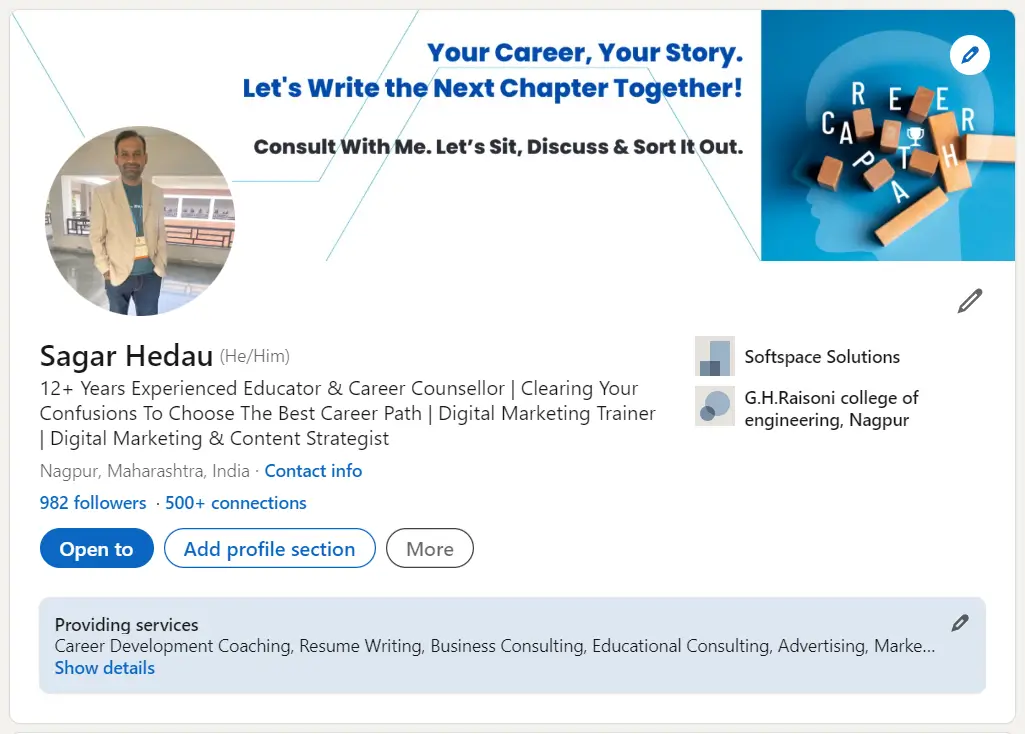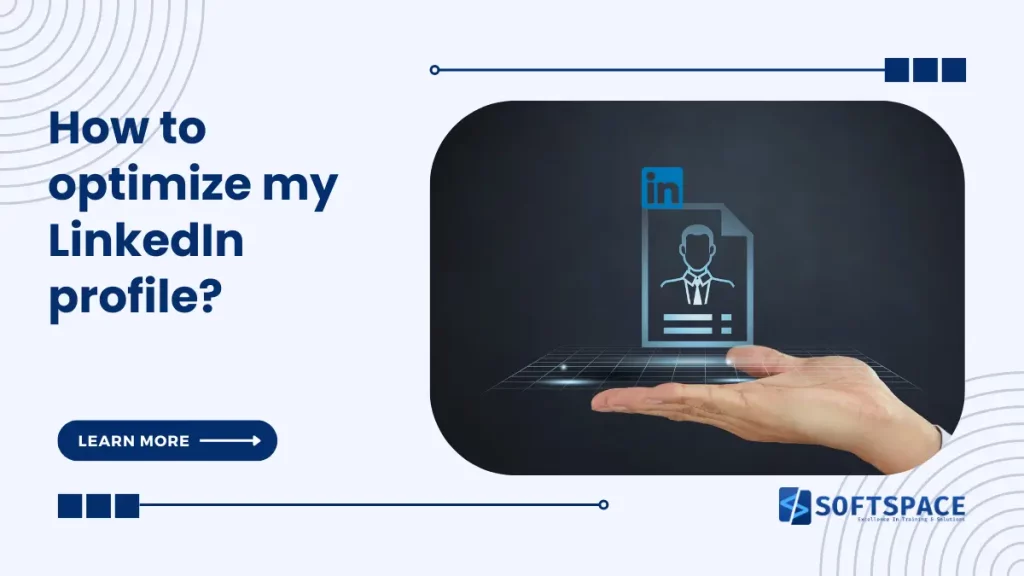In today’s digital age, LinkedIn has become the go-to platform for professionals looking to establish their online presence and unlock new opportunities. With over 700 million users worldwide, LinkedIn offers a unique platform for networking, job hunting, and personal branding.
As a professional, having an optimized LinkedIn profile is crucial for showcasing your skills, experience, and accomplishments to potential employers and clients. In this article, we will guide you through 10 essential steps to answer the question “How to optimize my LinkedIn Profile?” and the 10 easy ways to do it.
Table of Contents
How to optimize my LinkedIn Profile? Why is it important?

Your LinkedIn profile serves as your online resume and can have a significant impact on your professional success. When recruiters and potential clients search for professionals in your field, a well-optimized profile will increase your visibility and make a positive impression.
By showcasing your skills, experience, and accomplishments, you position yourself as a valuable asset in your industry.
Additionally, an optimized profile allows you to connect with like-minded professionals, join relevant groups, and stay updated on industry trends.
By neglecting to optimize your LinkedIn profile, you risk missing out on valuable networking opportunities and potential career advancements.
After you graduate or complete any job-oriented training programs, it is necessary to build an appealing LinkedIn profile for the audience to know you.
Understanding the LinkedIn algorithm and how it affects profile visibility
Before diving into the steps to optimize your LinkedIn profile, it’s important to understand how the LinkedIn algorithm works. The algorithm determines which profiles and posts are shown to users based on various factors, including relevance, engagement, and profile optimization.
By optimizing your profile, you increase your chances of appearing in search results and gaining visibility within your industry. The algorithm also takes into account the engagement your profile receives, such as likes, comments, and shares.
Therefore, it’s essential to not only optimize your profile but also actively engage with your network and share valuable content to maximize your visibility on LinkedIn.
Step 1: Choose a professional profile picture
Your profile picture is the first thing people see when they visit your LinkedIn profile, so it’s crucial to make a positive and professional impression. Choose a high-quality photo where you are dressed appropriately for your industry and have a friendly and approachable expression.
Avoid using casual or party photos, as they may not convey the professional image you want to portray. Remember, your profile picture should reflect your brand and help you make a strong first impression.
Step 2: Craft a compelling headline
Your headline is the line of text that appears below your name on your LinkedIn profile. It’s one of the most prominent sections and plays a crucial role in grabbing the attention of potential employers and clients. Instead of simply stating your job title, use your headline to showcase your unique value proposition and highlight your expertise.
For example, instead of “Marketing Manager,” you could write “Results-driven Marketing Manager with a track record of driving revenue growth and implementing successful digital marketing strategies.” By crafting a compelling headline, you can immediately capture the interest of those who visit your profile.
Step 3: Write a captivating summary
The summary section of your LinkedIn profile provides an opportunity to tell your professional story and give potential employers and clients a glimpse into your background, skills, and aspirations.
Use this section to showcase your unique strengths, accomplishments, and goals. Write concisely and compellingly, highlighting your key achievements and what sets you apart from others in your field.
Remember to tailor your summary to your target audience and use industry-specific keywords to increase your visibility in search results.
Step 4: Highlight your experience and accomplishments
The experience section of your LinkedIn profile is where you can showcase your professional journey, highlighting your past roles, responsibilities, and accomplishments. Be sure to include relevant details such as job titles, company names, and the duration of each role.
When describing your experience, focus on quantifiable achievements and results to demonstrate your impact. Use bullet points to make it easy for readers to scan through your experience and quickly grasp your key strengths and contributions.
Step 5: Showcase your skills and endorsements
LinkedIn allows you to list your skills and receive endorsements from your connections. Take advantage of this feature by including the skills that are most relevant to your industry and expertise.
Be strategic in selecting your skills and focus on those that align with your professional goals. Encourage your connections to endorse your skills, as endorsements provide social proof of your capabilities and increase your credibility.
Remember to reciprocate by endorsing the skills of your connections, as it strengthens your professional relationships and demonstrates your willingness to support others.
Step 6: Request and give recommendations
Recommendations on LinkedIn are powerful testimonials from colleagues, clients, or supervisors that validate your skills and expertise. Request recommendations from individuals who can speak to your professional abilities and achievements.
When asking for recommendations, provide specific prompts to guide the person in writing a meaningful and targeted recommendation. Additionally, take the time to give recommendations to others.
By giving recommendations, you not only contribute to the professional growth of your connections but also strengthen your own reputation as a generous and supportive professional.
Step 7: Join relevant LinkedIn groups and engage in discussions
LinkedIn groups provide a platform for professionals to connect, share knowledge, and engage in industry-specific discussions. Join groups that align with your professional interests and actively participate in conversations.
Share valuable insights, ask thoughtful questions, and connect with fellow group members. Engaging in discussions not only expands your network but also positions you as a knowledgeable and active participant in your industry.
Remember to be respectful and professional in your interactions, as your behaviour within groups reflects on your personal brand.
Step 8: Publish and share valuable content on LinkedIn
LinkedIn’s publishing platform allows you to share long-form articles and showcase your expertise in a specific area. Take advantage of this feature by publishing articles that provide value to your target audience.
Share insights, industry trends, and practical tips that demonstrate your knowledge and thought leadership. Additionally, regularly share relevant content from other sources to provide a well-rounded perspective to your network.
By consistently publishing and sharing valuable content, you establish yourself as a go-to resource in your field and attract the attention of potential employers and clients.
Step 9: Network strategically and build connections
LinkedIn is a powerful networking tool that allows you to connect with professionals from around the world. However, it’s important to approach networking strategically and focus on quality over quantity.
Instead of blindly sending connection requests, take the time to personalize your invitations and explain why you would like to connect. Look for professionals in your industry, colleagues, alumni, and thought leaders who can provide valuable insights and support.
Engage with your connections by congratulating them on their achievements, commenting on their posts, and reaching out for meaningful conversations. Building genuine relationships on LinkedIn can open doors to new opportunities and collaborations.
Step 10: Continuously update and optimize your profile
So, how to optimize my LinkedIn profile? How to get regular engagement and generate a probability of business or networking? As your career evolves and you gain new skills and accomplishments, it’s important to update your profile accordingly. Regularly review and refine your profile to ensure it accurately reflects your current professional status and goals.
Stay updated on the latest LinkedIn features and best practices to make the most out of the platform. By continuously optimizing your profile, you demonstrate your commitment to professional growth and increase your chances of attracting the right opportunities.
Conclusion
So, How to optimize my LinkedIn profile? By following these 10 essential steps, you can create a compelling and impactful profile that attracts the attention of potential employers and clients.
Remember to approach LinkedIn as a platform for networking, personal branding, and knowledge sharing.
Engage with your connections, share valuable content, and continuously update your profile to stay relevant in your industry. With an optimized LinkedIn profile, you can position yourself as a valuable asset and take your professional success to new heights.

13+ Yrs Experienced Career Counsellor & Skill Development Trainer | Educator | Digital & Content Strategist. Helping freshers and graduates make sound career choices through practical consultation. Guest faculty and Digital Marketing trainer working on building a skill development brand in Softspace Solutions. A passionate writer in core technical topics related to career growth.




